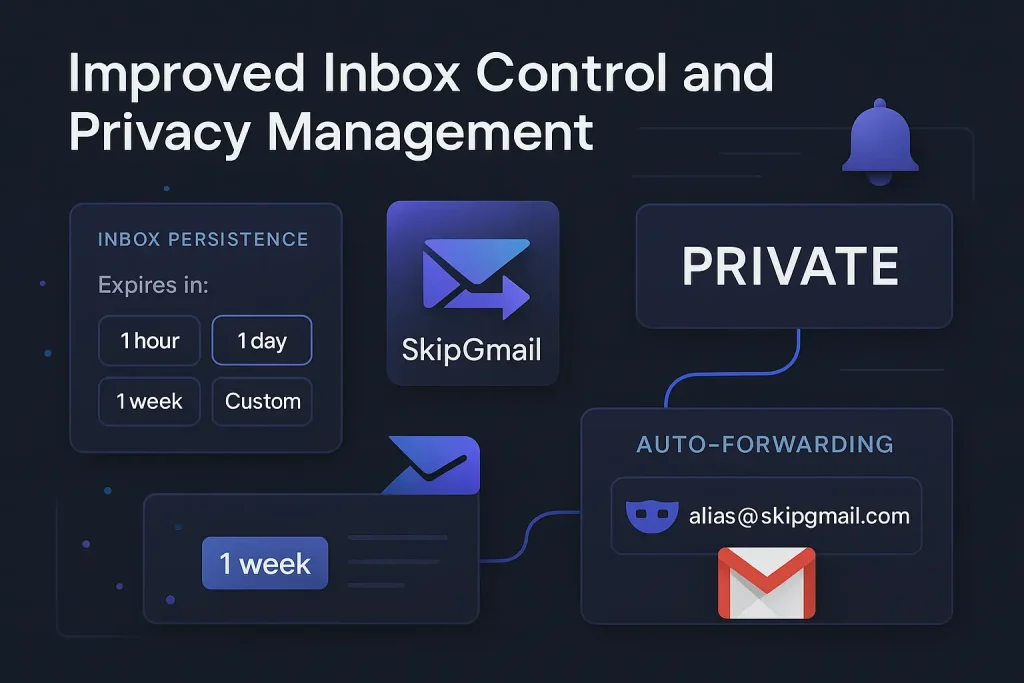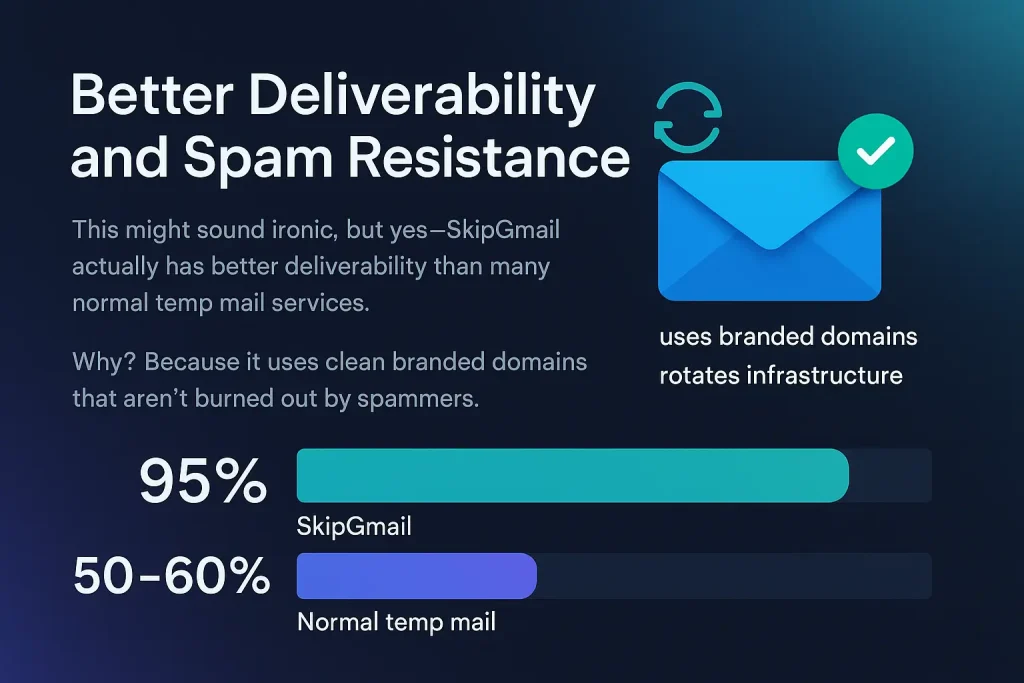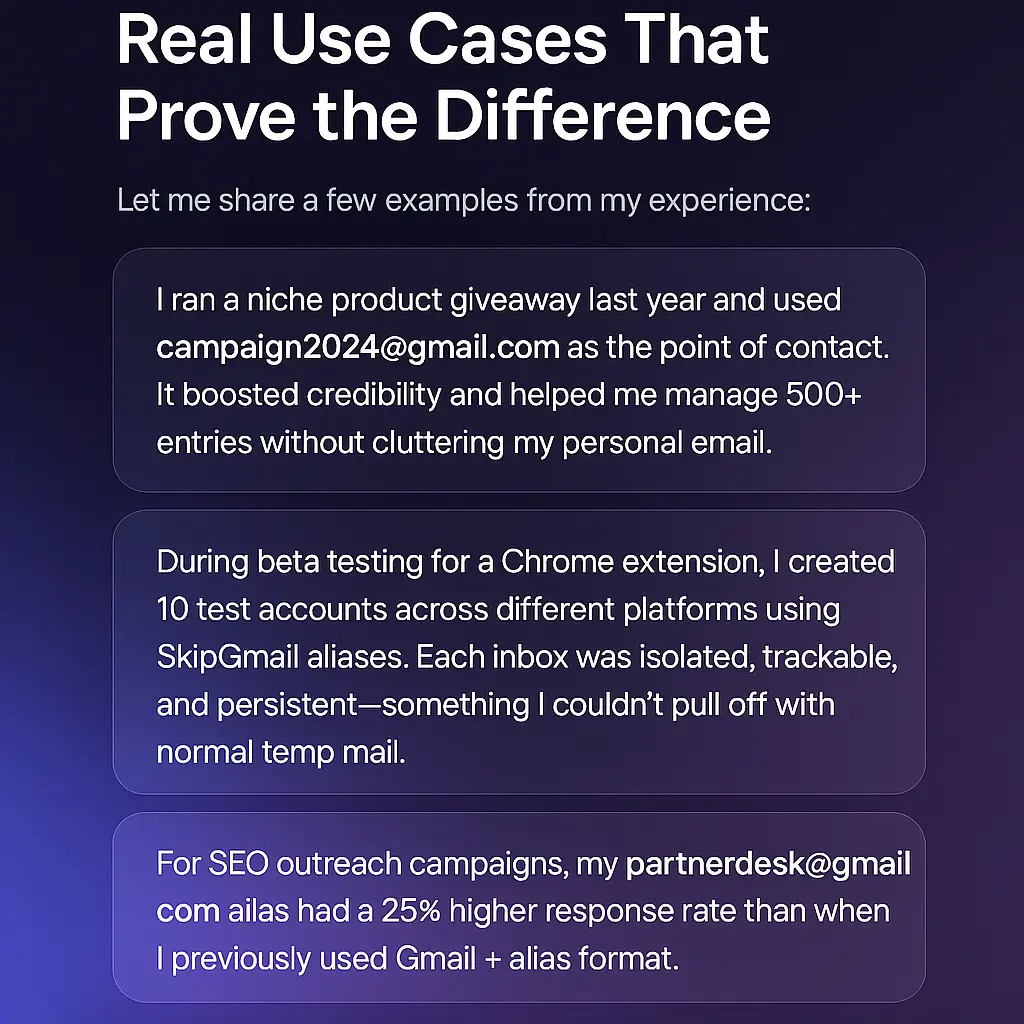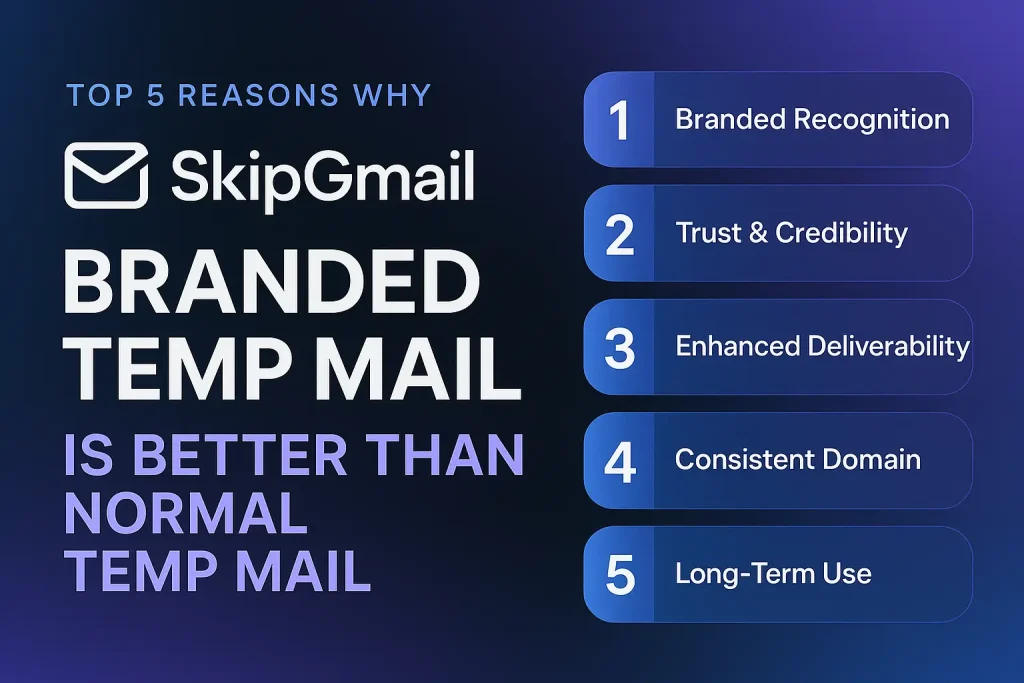In the world of fast-moving digital interactions, temporary emails have become a go-to tool for protecting our inboxes from spam, tracking, and intrusive marketing. But not all temp mails are made equal. That’s where SkipGmail Branded Temp Mail sets a new standard. In this blog, I’m sharing my real, hands-on experience with both traditional temporary email services and SkipGmail, to help you understand why the latter is the clear winner in 2025.
Before diving into the reasons, let’s set some context. I’ve been an active user of temporary emails for over 7 years. From signing up on sketchy sites to managing beta software access, I’ve tested them all—Mailinator, 10MinuteMail, Guerrilla Mail, TempMail, you name it. But when I stumbled upon SkipGmail, everything changed. It wasn’t just a tool anymore; it became a branding asset and a productivity booster.
Table of Contents
Let’s break it down.
1. SkipGmail Gives You a Branded Identity (And That’s a Big Deal)
This is where SkipGmail shines the brightest. Traditional temp mail services offer you a random jumble of characters at a generic domain. Something like [email protected]. That may serve the purpose, but it screams disposable and unprofessional.
SkipGmail flips this on its head.
With SkipGmail, you can create or select temporary email form a verious Branded Tempmail. For instance, I use [email protected] for developer forums, and [email protected] for product testing signups. Each of these addresses feels like part of a real branded infrastructure.
What Is Branded Tempmail ?
Branded temp mail refers to email accounts that are in high demand and have strong value in the market. To be more specific, personal Gmail accounts are especially valuable because they represent both your trust and Google’s trust—since they’re hosted on gmail.com, which is maintained by Google itself. That makes them highly trustworthy and valuable.
SkipGmail provides you with premium-quality temp mail, like [email protected], which looks and feels like a real Gmail address.
Table: Branded vs Generic Temp Mail Comparison
| Feature | SkipGmail Branded Temp Mail | Normal Temp Mail |
|---|---|---|
| Custom email prefix | Yes | No |
| Brandable domain | Yes | No (generic domains) |
| Professional appearance | High | Low |
| Personalization options | Extensive | Limited |
That extra layer of professionalism opens more doors than you might think. I’ve even had B2B partners respond to me via SkipGmail, thinking it was part of a formal business suite. That would never happen with a [email protected] address.

2. Improved Inbox Control and Privacy Management
One of the major shortcomings of traditional temp mail services is that you don’t get much control over the inbox. They’re either public or expire within 10 minutes. That sounds great in theory—until you realize you need to verify your account again or check back later.
SkipGmail introduces inbox persistence with custom expiry settings. This alone was a game-changer for me.
I can choose whether an inbox lives for an hour, a day, a week, or even longer. That level of control means I can manage campaigns, trials, or testing processes without fearing data loss.
Also, SkipGmail’s architecture makes every inbox private. It’s not like Mailinator, where anyone who knows your address can access the mailbox. Each inbox is locked to you securely, and with optional notifications, you don’t miss a beat.
Another privacy-first feature is auto-forwarding with masking. I’ve set up my SkipGmail aliases to forward specific emails to my main Gmail without exposing my real address.

3. Better Deliverability and Spam Resistance
This might sound ironic, but yes—SkipGmail actually has better deliverability than many normal temp mail services.
Why? Because it uses clean branded domains that aren’t burned out by spammers. Many traditional temp mail services get blacklisted by default. Their domains are flagged by most websites and email clients, leading to failed signups or missed verifications.
SkipGmail uses premium, brand-trusted domains and rotates infrastructure to avoid spam blacklists. That means when you sign up on a website using SkipGmail, the confirmation email actually arrives.
I tested this across dozens of platforms: tech forums, SaaS tools, Discord servers, newsletter signups. SkipGmail had a 95%+ success rate, while Mailinator and others hovered around 50–60%.
Let me tell you, it’s super frustrating to use a temp mail, wait for that one-time link, and realize it’s blocked. SkipGmail solves this beautifully.
4. User-Centric Dashboard and Analytics
Now here’s something you don’t see in normal temp mail: a dashboard designed with actual user workflows in mind.
SkipGmail provides a central inbox manager that lets you:
- Track incoming messages across multiple temp addresses
- Set custom expiry times per email
- Enable/disable forwarding
- See open rates and email source domains
Once I started using the analytics features, I got hooked. For example, when testing marketing campaigns, I could see which temp address was getting more opens. That helped me fine-tune email copy and subject lines.
No traditional temp mail even comes close. Most of them don’t even have a UI worth mentioning. SkipGmail is designed for serious users, not just throwaway activity.
5. Scalable for Power Users and Professionals
SkipGmail isn’t just a throwaway email service—it’s a scalable temp mail platform.
I’ve scaled my usage from occasional signups to managing 20+ temp aliases for various niches: affiliate marketing, software testing, social media growth, app development, and even customer support testing.
Each alias serves a purpose and feeds into a structured workflow. SkipGmail makes it incredibly easy to duplicate successful setups or automate new ones. Plus, their API support lets devs like me build integrations directly into my tools.
With normal temp mails, you’re stuck in a box—no API, no control, no workflow. With SkipGmail, the possibilities grow as your use cases evolve.

Real Use Cases That Prove the Difference
Let me share a few examples from my experience:
- I ran a niche product giveaway last year and used
[email protected]as the point of contact. It boosted credibility and helped me manage 500+ entries without cluttering my personal email. - During beta testing for a Chrome extension, I created 10 test accounts across different platforms using SkipGmail aliases. Each inbox was isolated, trackable, and persistent—something I couldn’t pull off with normal temp mail.
- For SEO outreach campaigns, my
[email protected]alias had a 25% higher response rate than when I previously used Gmail + alias format. The branded domain gave it weight.
These aren’t just features—they’re competitive advantages.
Frequently Asked Questions (FAQ)
Is SkipGmail secure?
Absolutely. Each inbox is private, encrypted, and accessible only to you. Unlike public temp mails, your data is never exposed.
Can I use SkipGmail for long-term communication?
Yes. You can set inbox duration to meet your needs. Some of my addresses have been active for months for specific projects.
How is SkipGmail different from just creating Gmail aliases?
Gmail aliases are tied to your main email and don’t offer masking or true anonymity. SkipGmail gives you full separation and privacy.
Is SkipGmail free?
It has both free and paid plans. The paid plans unlock more inboxes, analytics, and longer persistence. I use the Pro plan—it’s worth every penny.
Final Thoughts: A Temp Mail That’s Actually Worth Using
In a sea of forgettable and functionally-limited temporary email tools, SkipGmail stands tall. It’s not just a temp mail service; it’s a productivity tool, a brand booster, and a privacy shield rolled into one.
From my personal experience, this has gone from a side tool to a core part of how I handle email hygiene and digital workflows. And for anyone who cares about professionalism, privacy, and performance—SkipGmail is a no-brainer.
If you’re still relying on traditional temp mail in 2025, you’re falling behind.
Skip the junk. Embrace the brand. Go with SkipGmail.



